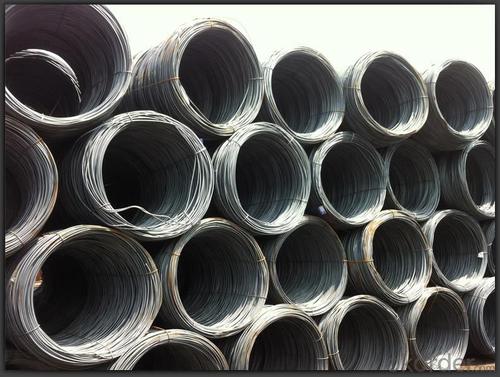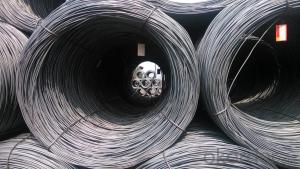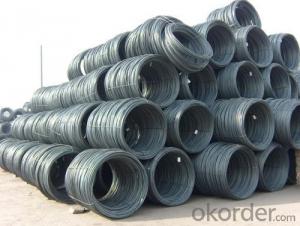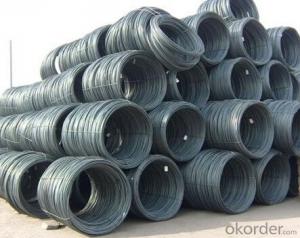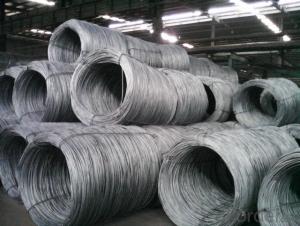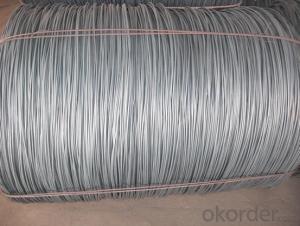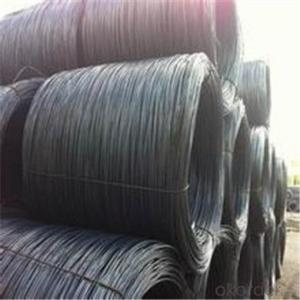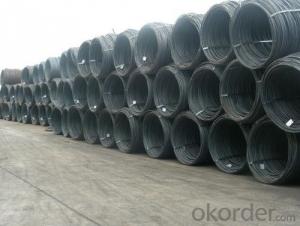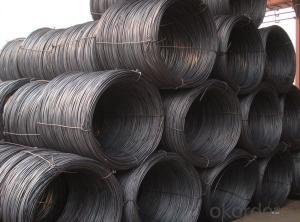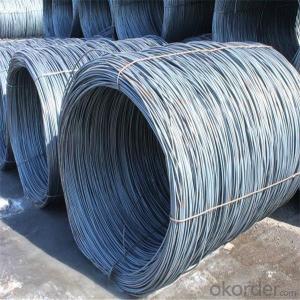Wire rod high quality hot rolled 5.5mm-14mm
- Loading Port:
- Tianjin
- Payment Terms:
- TT OR LC
- Min Order Qty:
- 25 m.t.
- Supply Capability:
- 20000000 m.t./month
OKorder Service Pledge
OKorder Financial Service
You Might Also Like
WIRE ROD Details:
| Minimum Order Quantity: | m.t. | Unit: | m.t. | Loading Port: | |
| Supply Ability: | m.t./month | Payment Terms: | TT OR LC |
Product Description:
Steel Grade: Q195 Standard: ASTM, GB
Diameter: 5.5mm, 6.5mm, 7mm,8mm,9mm,10mm,12mm,14mm
6.5mm can be drawing into 2mm/8.0mm can be drawing into 3mm
Type: Drawn Wire in Coil, each coil weight about 2MT
Brand Name: N-RIVER Place of Origin: Hebei, China
Chemical Composition:
Please kindly find our chemistry of our material based on Q195 as below for your information
Trademark | Rank | Chemical composition (quality score) % | |||||
C | Si | Mn | S | P | |||
≤ | ≤ | ≤ | |||||
Q195 | 0.06-0.12 | 0.30 | 0.25 | 0.050 | 0.045 | ||
Trademark | Rank | Pulling Test | |||||
Bend PointΔs/Mpa | Tensile Strength | Elongation Ratioδ5% | |||||
Thickness (Diameter) /MM | Thickness (Diameter) /MM | ||||||
≤16 | 16-40 | ≤16 | 16-40 | ||||
≥ | ≥ | ||||||
Q195 | 195 | 185 | 315-390 | 33 | 32 | ||
Usage and Applications of Wire Rod Q195:
After hot-rolled the products shaped into coil and delivery as finished product, including round, square, rectangular, hexagonal and so on. Since most of the products are round, it is generally called wire rod. Carbon steel wire rod is widely used in construction and manufacturing. Carbon steel wire rod is mainly used for reinforcement of reinforced concrete and welded structure or reprocessed (roberts , nail, etc.) materials, especially used to produce wire drawing, welding electrode, nails, spring, electronic, precise machinery parts and so on
Wire Rod in Container
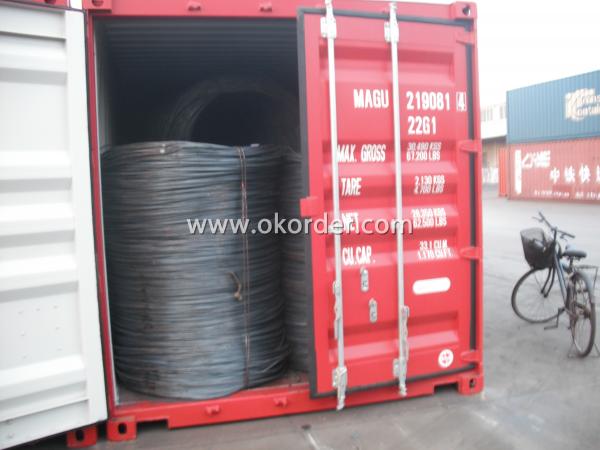
Wire Rod in Bulk Vessel
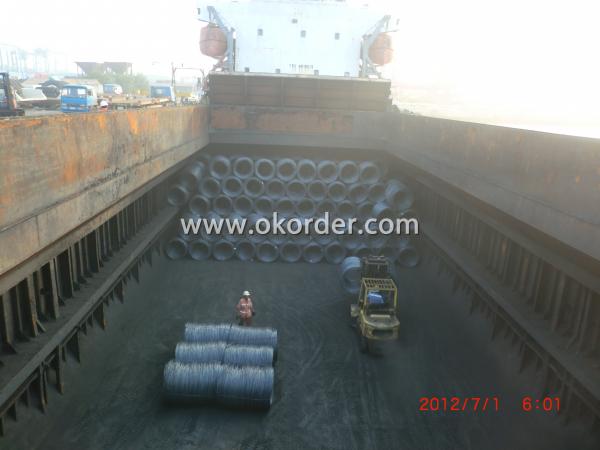
Note:
- Q: What are the different types of defects that can occur in steel wire rod?
- There are several types of defects that can occur in steel wire rods, including surface defects such as scabs, scratches, and pits. Other common defects include internal defects like cracks, voids, and inclusions. It is essential to identify and address these defects to ensure the quality and reliability of the steel wire rod.
- Q: How is steel wire rod classified based on its surface condition?
- Steel wire rod can be classified based on its surface condition as either bright or coated. Bright wire rods have a clean and smooth surface, while coated wire rods have a layer of protective coating applied to prevent rust and corrosion.
- Q: What are the strength requirements for steel wire rod used in suspension bridge wire strands?
- The strength requirements for steel wire rod used in suspension bridge wire strands can vary depending on several factors. Generally, the wire rod must possess high tensile strength to withstand the immense loads and stresses that suspension bridges are subjected to. The wire rod must have a minimum yield strength and ultimate tensile strength that meets or exceeds the design requirements for the suspension bridge. The yield strength refers to the amount of stress that the wire rod can withstand before it begins to deform permanently, while the ultimate tensile strength indicates the maximum stress the wire rod can endure before it breaks. In addition to high strength, the wire rod must also exhibit good ductility and toughness. Ductility refers to the ability of the material to deform without fracturing, while toughness is its ability to absorb energy without fracturing. These properties are crucial for structural integrity as they allow the wire strand to flex and absorb dynamic loads, such as wind or vehicle vibrations, without failure. Furthermore, the wire rod should have excellent corrosion resistance to ensure the longevity and durability of the suspension bridge. Corrosion can weaken the wire strands over time, compromising the structural integrity of the bridge. Therefore, the wire rod must possess a protective coating or be made from corrosion-resistant alloys to withstand exposure to environmental factors such as moisture, saltwater, and pollutants. Finally, the dimensional requirements of the wire rod, including its diameter and surface finish, must also meet the specifications of the suspension bridge design. These dimensions are crucial for maintaining the desired strength and performance characteristics of the wire strands. In summary, the strength requirements for steel wire rod used in suspension bridge wire strands include high tensile strength, good ductility, toughness, corrosion resistance, and adherence to dimensional specifications. Meeting these requirements ensures the wire strands can withstand the significant loads and environmental conditions experienced by suspension bridges, ensuring their structural integrity and safety.
- Q: How is steel wire rod used in the manufacturing of wire for musical instrument strings?
- Steel wire rod is a crucial raw material used in the manufacturing of wire for musical instrument strings. It is first drawn through a series of dies to achieve the desired diameter and shape. This process ensures that the wire is strong, durable, and has the necessary flexibility to produce the desired musical tones. The wire is then further processed, coated, and wound onto specific cores to create strings for various musical instruments, such as guitars, pianos, violins, and cellos. The quality and properties of the steel wire rod directly impact the sound quality, longevity, and performance of the instrument strings.
- Q: How is the steel wire rod industry regulated?
- The steel wire rod industry is regulated through a combination of government regulations and industry standards. Governments typically set regulations on areas such as product quality, safety standards, environmental impact, and labor practices. These regulations ensure that the industry operates within certain parameters to protect the interests of consumers, workers, and the environment. Additionally, industry standards and certifications are often established by professional associations or organizations to further regulate and ensure the quality and safety of steel wire rod products.
- Q: What are the different surface inspection methods for steel wire rod?
- There are several different surface inspection methods that can be used for steel wire rod. These methods are employed to ensure the quality and integrity of the surface of the wire rod. 1. Visual Inspection: This is the simplest and most basic method of surface inspection. It involves visually inspecting the surface of the wire rod for any visible defects such as scratches, dents, or corrosion. 2. Magnetic Particle Inspection: This method involves applying a magnetic field to the wire rod and then applying a magnetic particle solution on the surface. Any defects or cracks in the surface will cause the particles to cluster and become visible under UV light. 3. Eddy Current Testing: This non-destructive testing method involves inducing an electric current in the wire rod and measuring the resulting electromagnetic field. Any variations or anomalies in the electromagnetic field can indicate surface defects. 4. Ultrasonic Testing: This method uses high-frequency sound waves to penetrate the surface of the wire rod. The sound waves are reflected back when they encounter any surface defects or cracks, allowing for their detection. 5. Dye Penetrant Inspection: This method involves applying a liquid dye to the surface of the wire rod. The dye is then allowed to seep into any surface defects or cracks. After a certain period of time, the excess dye is removed, and a developer is applied to make the defects visible. 6. Laser Scanning: This advanced method utilizes laser technology to scan the surface of the wire rod. The laser detects any deviations from the normal surface profile, such as dents or scratches, and provides a detailed analysis of the surface condition. 7. X-ray Inspection: This method is used to inspect the internal and external surface of the wire rod. X-rays are passed through the wire rod, and any defects or anomalies are detected by the variations in the intensity of the X-ray beam. Each of these surface inspection methods has its own advantages and limitations. The choice of method depends on the specific requirements, the type of defects to be detected, and the level of accuracy needed for the inspection.
- Q: What are the different types of steel wire rod surface defect analysis tools?
- There are various types of tools used for the analysis of surface defects in steel wire rods. Some commonly used tools include optical microscopes, scanning electron microscopes (SEM), digital imaging systems, and surface profilometers. These tools allow for detailed examination of the wire rod surface at different magnifications, enabling the identification and characterization of various types of defects such as cracks, pits, scratches, and scale.
- Q: What are the differences between wire rod, round bar and thread steel? Respective specifications?
- Round wire, including wire rods, refers to a smooth surface, mainly galvanized round steel, generally 10--12 in diameter, but also of larger diameter but rare. Threaded steel refers to the surface of the thread. Commonly used with diameter 10--25. Generally 2 grade steel
- Q: What are the common applications of low alloy and oil tempered steel wire rod?
- Some common applications of low alloy and oil tempered steel wire rod include automotive components, construction materials, wire ropes, springs, and cables. These types of steel wire rod offer enhanced strength, durability, and resistance to corrosion, making them suitable for various industries where high-performance materials are required.
- Q: What are the main factors influencing the choice of steel wire rod order return policy?
- The main factors influencing the choice of steel wire rod order return policy are the quality of the product, customer satisfaction, and market competition. Firstly, the quality of the steel wire rod plays a crucial role in determining the return policy. If the product is consistently of high quality and meets the customer's expectations, the need for returns will be minimal. In such cases, a more stringent return policy can be implemented, ensuring that only genuine defects or issues are eligible for returns. On the other hand, if the product quality is inconsistent or below standard, a more lenient return policy may be required to accommodate customer dissatisfaction and maintain good customer relations. Customer satisfaction is another important factor. A customer-centric approach should be taken into consideration while devising a return policy. By providing a flexible and hassle-free return policy, customers will feel more confident in their purchasing decisions, knowing they have the option to return the product if they are not satisfied. This can help build trust and loyalty, leading to repeat purchases and positive word-of-mouth recommendations. Additionally, market competition plays a significant role in determining the return policy. In a highly competitive market, where customers have numerous options to choose from, a lenient return policy can act as a differentiating factor. By offering a more favorable return policy compared to competitors, a company can attract more customers and gain a competitive edge. However, this needs to be balanced with the company's profitability and operational feasibility, as overly generous return policies can impact the bottom line. In conclusion, the main factors influencing the choice of steel wire rod order return policy are the quality of the product, customer satisfaction, and market competition. A well-planned return policy that considers these factors can help ensure customer loyalty, maintain a positive brand image, and stay competitive in the market.
Send your message to us
Wire rod high quality hot rolled 5.5mm-14mm
- Loading Port:
- Tianjin
- Payment Terms:
- TT OR LC
- Min Order Qty:
- 25 m.t.
- Supply Capability:
- 20000000 m.t./month
OKorder Service Pledge
OKorder Financial Service
Similar products
Hot products
Hot Searches
Related keywords



